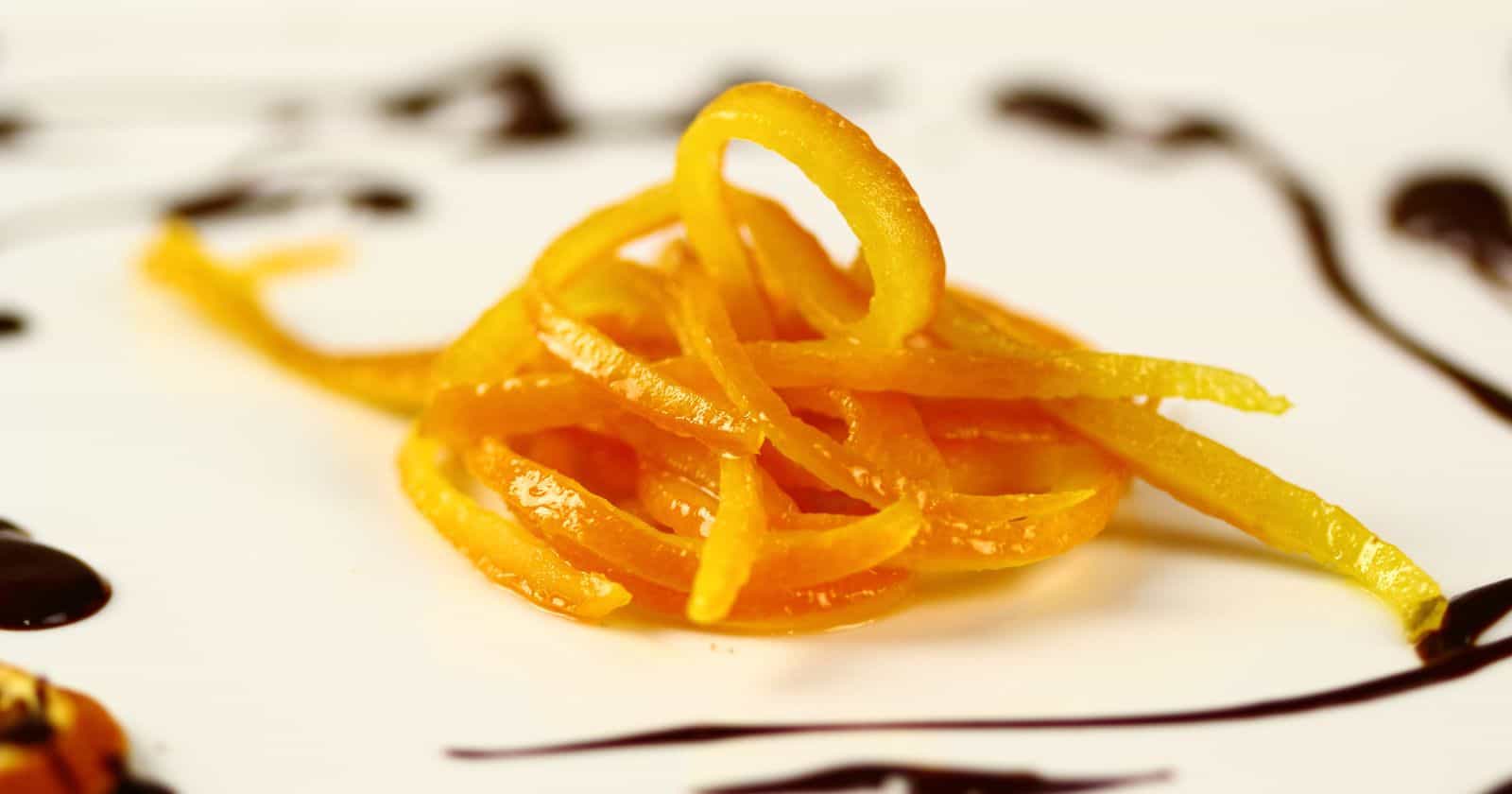Orange zest is the secret ingredient that can take your cooking to the next level. Whether you’re a professional chef or a home cook, adding orange zest to your dishes can give them a bright and fresh flavor.
However, some people may need to be aware of the benefits of using orange zest in their cooking or how to properly zest an orange without getting any bitter pith.
In this article, we’ll explore everything you need to know about using orange zest in your cooking and how it can enhance the flavor of your dishes.
First, let’s talk about what orange zest is and how to remove it from the orange peel properly. Orange zest is the colored part of the peel that contains essential oils and a strong citrusy flavor. You can use a fine grater or vegetable peeler to zest an orange.
It’s important to be gentle when removing the zest, ensuring not to get any bitter white pith beneath it. Once you have the zest, you can use it in various sweet and savory dishes, such as cakes, cookies, marinades, dressings, and sauces.
In the following sections, we’ll explore how you can use orange zest in your cooking and how it can be a versatile and tasty addition to many dishes. We’ll also provide some recipe ideas and tips for using the dried or pre-packaged orange zest.
By the end of this article, you’ll be ready to incorporate orange zest into your cooking routine and impress your friends and family with your new culinary skills. So, let’s get started!
What Is Orange Zest?
Orange zest is the bright, flavorful outer layer of an orange peel that is used to add a zesty kick to various dishes. This ingredient is commonly used in salad dressings, baked goods, marinades, and many other recipes to give a burst of citrus flavor that takes words to the next level. You can easily make it by removing the colorful part of the orange peel using a microplane, grater, or small knife.
Here are some more exciting facts about orange zest:
- Orange zest is loaded with essential oils that give it bold flavor and aroma. These oils contain limonene, also found in lemon oil, and has a fresh, tart scent, and pinene, which has a woody, pine-like scent.
- Orange zest is high in vitamin C, antioxidants, and other beneficial nutrients. Adding it to your meals can help boost your immune system, ward off colds and flu, and even fight cancer.
- You can use orange zest in both sweet and savory dishes. For example, you can add it to pancake batter or cookie dough to give your breakfast or dessert a tangy flavor or mix it with olive oil, garlic, and herbs to make a delicious marinade for chicken or fish.
How to Use Orange Zest in Your Cooking
Orange zest is an excellent ingredient to add a citrusy flavor to your cooking. To use it in your dishes, you can easily remove the colored part of the peel by grating it with a microplane or grater. But how exactly can you use orange zest in your cooking? Here are some delicious ways to add this ingredient to your recipes:
- Baked goods: Add flavor to your cakes, cookies, and muffins by including orange zest in the recipe. It works well with other ingredients like vanilla, cinnamon, and chocolate.
- Salad dressings and sauces: Use orange zest in vinaigrettes or creamy dressings to add a lively touch to your salads. It also pairs well with soy sauce, honey, and ginger in Asian-style sauces.
- To elevate their flavor, roasted vegetables and grilled meats: Sprinkle orange zest over roasted carrots, sweet potatoes, and other vegetables. You can also use it as a seasoning for grilled chicken or fish alongside herbs like thyme and rosemary.
Recipes Featuring Orange Zest
Are you looking for a new addition to your dessert recipes? Try using orange zest to add a citrusy flavor to your sweet treats! Orange zest can be used in various desserts, making it a versatile ingredient in the kitchen. Some popular recipes include:
- Spiced dried fruit cake with rum butter glaze
- Honey orange cheese blintzes
- Citrus upside-down cake
- Orange cookies with sweet orange glaze
- Scratch-made orange zest pound cake with orange curd
Not only can you use orange zest in these delicious desserts, but you can also make powdered orange zest, candied orange peel, and healing salve.
Plus, it can be added to sugar scrubs and cakes like the ultimate orange cake recipe that uses fresh orange juice and zest.
Here are some creative ways to incorporate orange zest into your cooking:
- Use orange zest as a garnish on top of your favorite dishes
- Add orange zest to your morning smoothie for some extra zing
- Use orange zest in your marinades for a citrusy flavor
- Incorporate orange zest into your homemade granola or trail mix for a burst of flavor
- Use orange zest to make a homemade vinaigrette or salad dressing
Using Dried or Pre-Packaged Orange Zest
Using dried or pre-packaged orange zest is a great option when fresh orange zest is unavailable. It can be easily found in grocery stores and is convenient when cooking or baking.
Dried orange peels can be ground into a fine powder and added to recipes, and pre-packaged orange zest can be added directly as a substitute for fresh zest.
However, it’s important to note that fresh orange zest will provide the best flavor and aroma in your dishes.
Dried Orange Peels:
- To make dried orange zest, spread it thinly and freeze it.
- Once frozen, break it up and store it in an airtight container in the freezer for six months to one year.
- Dried orange peels can be ground into a powder and used in baking to add a citrusy flavor to desserts such as cakes, cookies, and bread.
Pre-Packaged Orange Zest:
- This orange zest is readily available in grocery stores and can be used as a substitute for fresh
spice in various recipes. - Pre-packaged orange zest is a convenient option when baking, as it eliminates the need to zest fresh oranges.
- It can be added directly to dishes, such as marinades, dressings, and desserts, to give them a citrusy flavor.
Fresh Orange Zest:
- Fresh orange zest provides a best flavor and aroma than dried or pre-packaged
spice . - Zest can be obtained by grating the outer peel of the orange using a zester or fine grater.
- It can be used in a variety of recipes, such as sauces, marinades, desserts, and beverages, to add a bright, citrusy flavor.
Tips and Tricks
Orange zest is a delightful ingredient that can add an extra punch of flavor to your favorite dishes. Luckily, you can use many tips and tricks to get the most out of this versatile ingredient.
With its bright color and unique flavor, orange zest can add a touch of zing to almost anything. One tip is to use orange zest to enhance the citrusy taste in your recipes without adding more liquid.
This can be especially useful in sauces, salad dressings, and even bacon jam! Another way to use orange zest is to add it to baked goods or DIY cosmetics.
When it comes to preparing orange zest, it’s essential to be careful not to include the white pith that separates the peel from the fruit. The center is bitter and can detract from the bright flavors of the zest.
To get the most taste from your orange zest, consider using a microplane or grater to remove only the colored part of the peel.
Looking for even more tips and tricks for using orange zest? Here are a few more ideas:
- Add a fresh, summery flavor with orange zest in marinades for fish or chicken.
- Add a flavor to your morning oatmeal by sprinkling in a bit of orange zest before cooking.
- Mix orange zest with butter and herbs to create a flavorful rub for roasted vegetables.
No matter how you choose to use orange zest, it’s sure to bring some extra brightness and flavor to your favorite dishes.
Orange Zest Substitute
Orange zest substitute is a great solution when you want to add a citrusy flavor to your dishes without real orange zest.
Several substitutes are available in your recipes, such as dried orange peel, grapefruit zest, lemon zest, lime zest, orange extract, and orange juice.
Dried orange peel is perfect for main course dishes and baked goods, as it can add a bright citrus flavor. Grapefruit zest is also an excellent substitute for orange zest because of its similar flavor profile.
If you don’t have either of those options, you can always use lemon or lime zest to get that citrusy taste you desire. It’s also worth considering that orange extract and orange juice can be used, but these may not provide the same texture or aroma as fresh or dried orange zest.
When substituting orange zest, it’s essential to keep in mind that the flavor or aroma may vary depending on the type of substitute you use.
For instance, if you use dried orange peel, the taste may be different from the fresh orange zest. It’s also important to consider the recipe and the amount of substitute you need to use, as this will affect the overall taste and quality of the dish.





